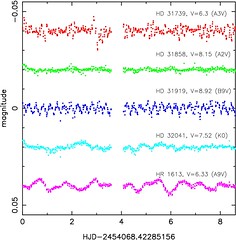Argh. I had just finished a lengthly blog entry and then found out that google has changed blogger since the last time I posted (1 year ago!). I guess that will teach me to wait so long between posts.
Anyways, I lost track of blogging as I was busy finishing my thesis, defending, finding a job and moving. Well that's all done now. I successfully defended and submitted the thesis. I am no longer a student. Being a poor grad student was being to really suck, now I can be a not-so-poor poctdoc. As a result, I've moved from Vancouver to San Jose and now work at NASA-Ames with the Kepler project. That alone should give me plenty to chat about in the future.
I've been working recently on trying to publish some results on the binary system system HR 1613. The figure above shows an 8.5 days observing campaign from the MOST satellite. The magenta lightcurve at the bottom shows the variability of the stellar system.
The primary, more massive, member of the system is a 1.5 solar mass main-sequency star (A9 V) and the secondary is a less massive and intrinsically less bright K or M-dwarf star. The A9V star shows variability on the time scale of a day. It appears to be gamma Doradus type pulsations. I've discussed these type of pulsations before in my study of the star BD+18 4914. The interpretation is that these are g-modes which may be driven by the star itself or excited by tidal interaction with the companion star.
The other 4 lightcurves show a wide range of stellar activity for different temperatures and mass. The top (red) curve shows a hotter, more massive A-type star which shows variability on the timescale of an hour. These are interpreted as p-mode pulsations and the star is likely a delta Scuti type pulsator. The next (green) curve shows a star with a very similar temperature, but does not show any intrinsic variability. It's evolutionary stage is unknown. The 1 day modulation that you can see by eye in the light curve is an instrumental artifact. It was purposely left in the lightcurve to show its effect on the photometry.
The middle curve (blue) shows a relatively hotter B star. The variability pattern and stellar classification are consistent with being a beta Cephei type star. The next curve (cyan) shows a cooler K-type star. The erratic behaviour in the lightcurve is likely caused by spots on the surface of the star which rotate out of view as the star rotates and change shape as influenced by the stars magnetic field.
Each star shows a unique lightcurve which we can use to probe the internal structure of star, which inturn allows us to infer the star's past and future. It's a very interesting science, to understand the points of light that we see on a clear night.
Thursday, January 24, 2008
Subscribe to:
Post Comments (Atom)

No comments:
Post a Comment